The Solomon Pierson Miles Presentation Teapot
In early February, 2013, I went to the Lynnwood, Washington Goodwill store in my usual quest for inventory for my eBay business. In the knick-knacks aisle, tucked among the donated Dollar Store decor items,stood a teapot, black with age and dented here and there. I’m not sure what made me pick it up, except that I usually pick up silverplate, hoping to find sterling. It has happened before. Maybe it was the laid-in detailing, the ear-of-corn-shaped finial on the lid, or the ivory spacers in the handle. I’m not sure.
I was disappointed, though – the bottom didn’t say ‘sterling” or have any British sterling marks. It didn’t say ‘silver over copper’ or even ‘quadruple plate’ as I expected from the blackened surface. It just said, ‘Boston, ‘ ‘Jones, Lows & Ball,’ and then a curved, illegible stamp.
I might have put it back, but the side was engraved in a fabulous Copperplate handwriting, the only area of the teapot which had been polished many times. I can imagine countless people trying to decipher what this meant:
It says:
S.P. Miles
from
His Pupils
The English High School, Boston
from 1823 to 1837
If it hadn’t been inscribed, I still think I would have put it back. The inscription intrigued me, though. who was S.P. Miles? What did the date mean? Did it mean the teapot was really as old as it looked based on the inscription date? So, I bought it. $12.99 plus 9.5% WA state sales tax. I took it home and began researching.
My old friend Helen Schinske gave me the first hook into history, posting this to my Facebook page where I first presented the mystery:
“Solomon Pierson Miles, father of Charles Appleton [Miles], was a leading educator of this country, ranking with such men as Horace Mann and George B. Emerson, and was well known in the best circles of Boston, where he labored for many years. He was born January 22, 1791. Profiting by such educational advantages as lay in his power, he entered Harvard College, from which he graduated in 1819. After filling the position of instructor in his alma mater for some years, he decided to devote his life to the promulgation of higher educational methods, and accepted a position as head master of the Boston high school, and there put into practice many of his advanced theories. For nearly twenty years he conducted this institution, with remarkable ability and success. He then opened a private school for the instruction of girls in Boston. Here he was even more successful than he had been in his public school work. May 27, 1833, he married Sarah Elizabeth Appleton, the eldest daughter of Nathanael Walker and Sarah Tilden Appleton. Solomon P. Miles died August 22, 1842.”
From: Genealogical and Family History of the State of Vermont: A Record …, Volume 2 edited by Hiram Carleton, p 507
I also discovered that a) the English High School is still in the business of educating students today, and b) Jones Lows & Ball is still in business also, though it now goes by the name of Shreve, Crump & Low. As it turns out, Jones Lows & Ball only used that particular stamp from 1839-1845. Mr. Miles died in 1842. Assuming it was not presented posthumously, that dates this teapot definitively within a 3-year window: it is between 174 and 171 years old.
Once I understood I had a genuine historical artifact in hand, there was never any question in my mind. Of COURSE it should go home to Boston. History matters. The past matters. It would have been wrong for me to sell the teapot for scrap, knowing it meant something.
Now to insert some of that history. It was traditional at that time in history to present a teapot to an outgoing educator. The best explanation I have found is that a teapot was symbolic of hospitality; of meeting people to talk and socialize over tea, and was therefore an indication of hope for future social meetings with the departing individual. Given the role Mr. Miles played at the English High School, he well deserved a teapot. That his former pupils gave him a pure coin silver (which is what the illegible curved stamp should have said) teapot (‘coin silver’ was the same purity as was used for minting coins, and sometimes actual coins were incorporated into such items if the craftsman didn’t have enough metal for a project) speaks volumes of their regard for him. (According to the proprietor of the Antique Bank in downtown Bothell, WA, finding something from Jones, Lows & Ball is about the equivalent of finding a piece crafted by Paul Revere – that’s how highly they regarded their former Headmaster!) Furthermore, the Headmaster role at that time was not identical to today’s job of Principal — not merely administrative. The Headmaster did all those things, and he also taught the Senior class all their subjects (and at that time in history, most of the boys in the English High School were destined to continue on to Harvard, which was the local University). The Headmaster had to be prepared to teach the outgoing class ALL their subjects at a college-prep level. Each Master had a class, you see, and he taught his class all subjects rather than changing from room to room, and from one subject-specific teacher to another as we do now. Anyway, to continue:
There are a number of mentions of Mr. Miles available through Google Books (without which I could have done none of this) but i think this is the most characteristic, being given in a memoir written by one of his former pupils:
“Business summoning him away one afternoon, he trusted the school to the charge of a monitor, expressing a hope that his confidence would not be abused. But on his return his ears were greeted, even from a distance, by an uproar. The sentry at the door, however, giving notice of “the master,” all was a scene of apparently absorbing study as he entered. This hypocrisy probably touched him more keenly than our quite natural roguishness, for it was with a tone of most unusual severity that he said, “Let the boys who have been guilty of this disturbance come forward.” No one stirred, the big fellows especially, who had been ringleaders, sitting shrouded in a most imperturbable air of injured innocence. After waiting in silence, and looking from face to face, he continued, “Has no one courage to be true? “Then, up from the benches of the smaller boys rose James, and, with a friend of about his own age, walked steadily down the aisle, until confronted with the ruler of our little realm. It was with a clear, calm tone, and a look of sorrow, not fear, that he confessed his trifling share in the tumult; -and incentive indeed it was to frankness for a lifetime, when, placing his hand on the heads of the young friends, and with a few words to the school in commendation of their honor, the much loved teacher forgave them.”
To return to the narrative: I contacted EHS to ask if they would be interested in acquiring the teapot, taking care to make sure they knew I really did have the item in question – in fact there was some brief confusion on that matter, and I was contacted once early on by a member of their IT department under the mistaken impression I might just be a more sophisticated sort of email scammer. But, I sent lots of pictures, the kind that could only exist if I took them myself. The matter was handed over to one Esmirna Soto, who began acting as my contact with the school district.
I wanted to send it to them right away, but there steps that had to be taken first. I needed to have the teapot appraised so it could be sent insured for the correct value. Also, Boston got hammered by Blizzard Nemo, and the Alumni Association board had to meet to discuss how they wished to proceed. I always assumed they would want it – Ms. Soto absolutely wanted to see it come home! – but without the board’s word, that was not a guarantee.
My children went with me to Omega Silversmithing in Snohomish, Washington to deliver the teapot to be appraised. Tim Maple, a local craftsman who has appeared as an expert on Antiques Roadshow, appraised it, identifying a replaced ivory spacer in the handle, a poorly-inserted pin holding the handle in place, and other minor damage such as the spout being bent in at the tip and the base not being flat. He said that while this reduced the monetary value, it increased the teapot’s character – someone dropped it, someone bumped and dented it, somebody cared enough to have the handle put back on; somebody didn’t quite have the skill to do the repair properly. Mr. Maple also gave me a quote on conservation care and minor repairs. I sent the appraisal and his estimate for repairs, if desired, to the Alumni Association to help them make their decision. I missed the March meeting date, pushing off any Board decision until the April meeting. More waiting!
Finally, finally, toward the end of April – when I didn’t expect to hear anything, due to the Marathon bomb tragedy – I received an email from Tom Dennehy, Vice President of the Alumni Association. The board had agreed upon an acquisition price, which covers my expenses plus a bit. He sent a check and his vast gratitude and thanks. The afternoon it arrived, the box went in the mail, Priority, Registered, and insured for the appraised value. Sadly, you can’t insure for historical value!
The teapot will be taken to Shreve, Crump & Low for conservation care. The board of the Alumni Association feels, as I do, that it is fitting and right for the company that made it to do the minor repairs it needs…170+ years later. And who knows? Maybe one day I’ll go to Boston and see it again. In the meanwhile, I have this, which arrived in my mailbox on Saturday the 11th, a bit more than 3 months from the day I happened to pick up a blackened old metal teapot and read the engraving on the side.
Geneological note. I spent several fascinating afternoons on Ancestry.com and Google, plus a phone call, and here is how I think it got to the Lynnwood Goodwill:
Solomon Pierson Miles (1791-1842), left behind a son Charles, age 8, and several younger daughters.
Charles Appleton Miles (1834-1911) inherited the teapot. He married Fanny Glover Train, and they had one son. (Reference: Annals of Battleboro, pp 661-664) Note: Col. Charles Miles saw action as a volunteer with a Massachusetts brigade during the US Civil War.
Appleton Train Miles (1895-1921) inherited the teapot. He was the first young man from Brattleboro, VT to volunteer to fight in WWI. He fought with great distinction and was awarded the Croix de Guerre, the Palm, and the Legion of Honor by the government of France. Upon returning home, he married Lillian S. Lawton, and they had one son. He died in Hartford, CT of blood poisoning at the age of 27, on December 20, 1921 when the baby was 6 months old (reference PDF scrapbook, p 107).
Appleton T. Miles Jr. (1921-2001) inherited the teapot from the father he never knew. His widowed mother moved first to Tampa, FL and then to Hollywood, CA, where her widowed mother joined them. Appleton Jr presumably had no contact with his father’s family, but his mother, who apparently never remarried, kept the teapot even through the difficulties of the Depression. Appleton Jr. fought in WWII (discharged 1944). In about 1962, he and his wife moved to Edmonds, WA. He married Marjorie Miles (maiden name may have been Morgan). They had one adopted son. Appleton served during World War II, after which he lived and worked in Edmonds, Washington, as a banker.When Appleton Jr died in 2001, the teapot was still in his possession.
Marjorie Miles sold the house in 2003. The gentleman who lives there today said the house was full of ‘stuff’ when he bought it, but he didn’t remember a big silver teapot. He did remember Marjorie having a big garage sale before she moved out. Marjorie passed away in 2007. The adopted son is not in the picture.
Note: the address at which Appleton Jr. lived is about 2 miles away from the Lynnwood Goodwill where the teapot was discovered.
It seems pretty straightforward: While Appleton Jr. may have had an attachment to the teapot because it came from his great-grandfather, his aging and ailing wife, moving out of her home of many years into a care facility, had no such attachment – or needed money very badly – or perhaps both. Unless I hear otherwise, I assume somebody in the neighborhood bought it at the garage sale, held onto it for a decade, and then donated it.
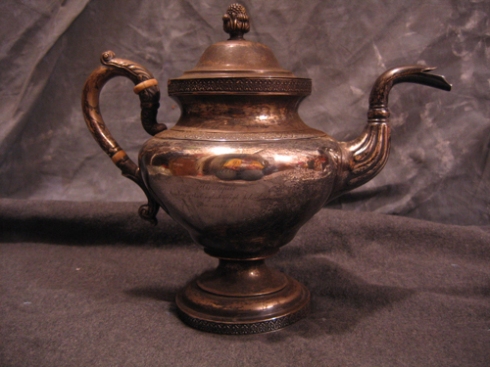
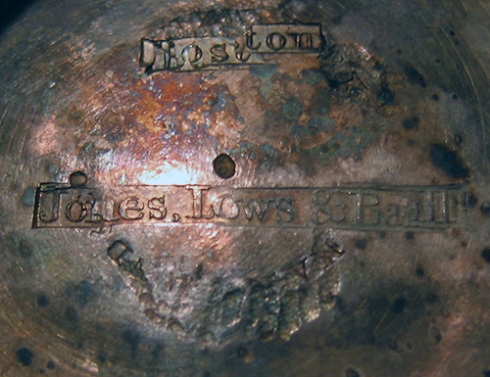
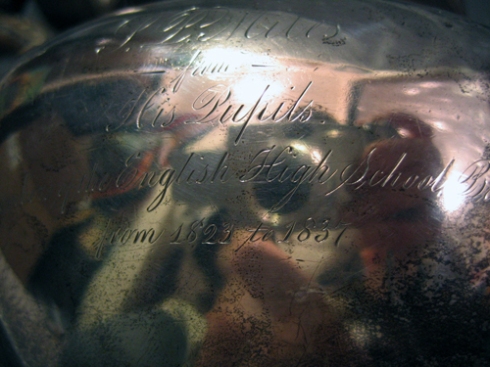
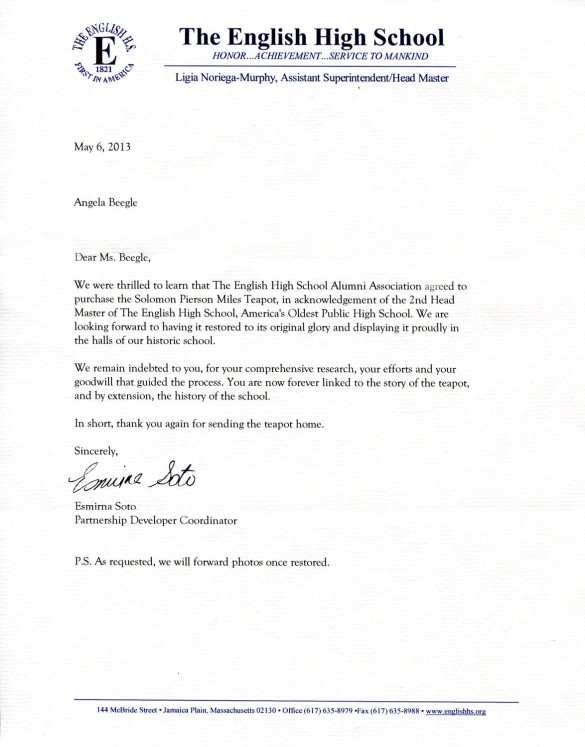
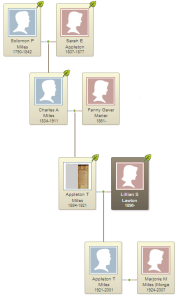
Amazing and fantastic. This story blends all my loves: history, antiques and genealogy. I ‘happened’ upon the story because I was doing research on a set of 12 heavy silver forks that we ‘inherited’ from family and wanted to know their background. It is somewhat the same, except a distant relative cared enough to entrust the into our care. I will attempt to write out the story of our forks – and keep it for the next generation to value. Your certainly lived up to your name – ANGELa!
Thank you. I’m sorry it took so long to get back to you on this – you know how it goes, email comes in and scrolls other mail down and down until it’s out of sight. I’d love to hear the story of the forks you’re researching. I have not heard back from the Alumni Association, but they promised they’ll send pictures when it’s all restored. I’m looking forward to that, too. 🙂